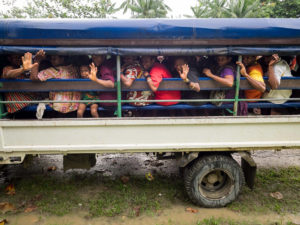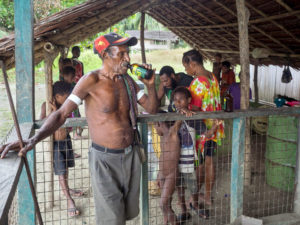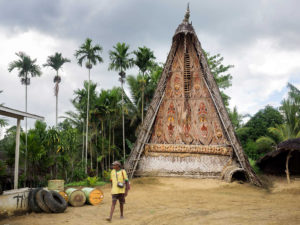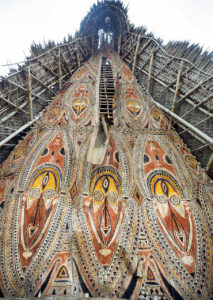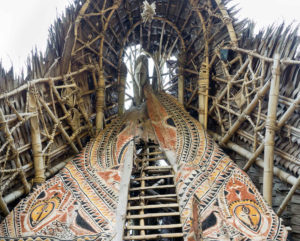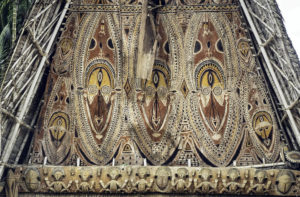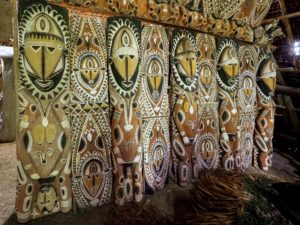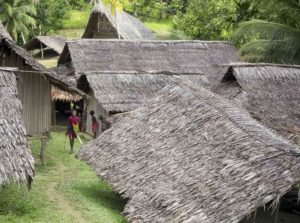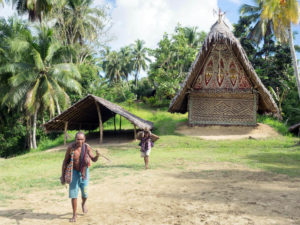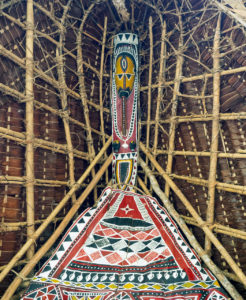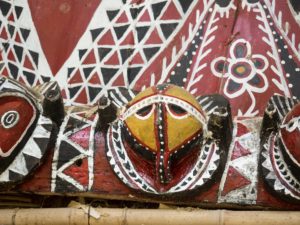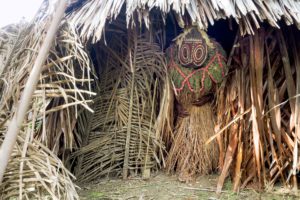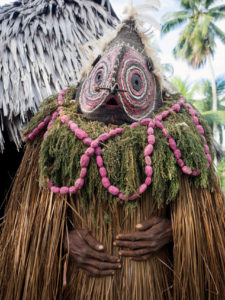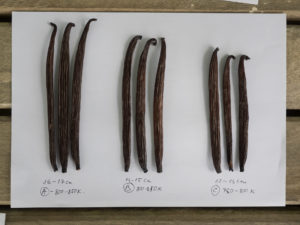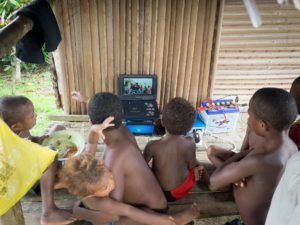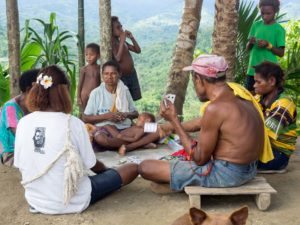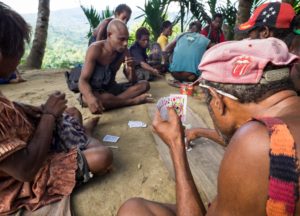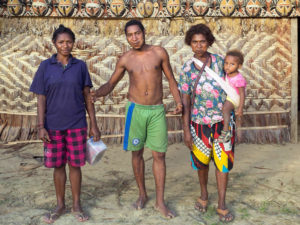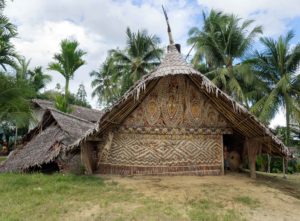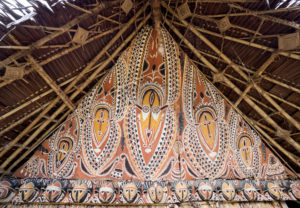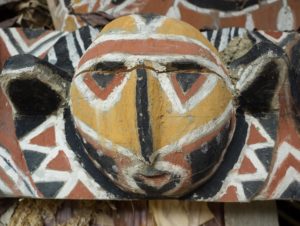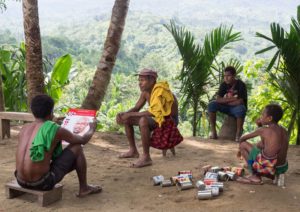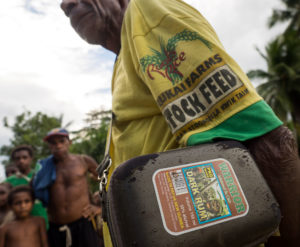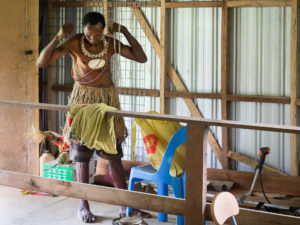
A Kwoma epic tells about a mighty spirit-yam who was living in a deep water pond, up, on a tree. When a man discovered the pond, he stared into the water, and the spirit-yam burst, throwing plenty of thorns and killing him. The yam turned the water pond into a waterfall and scattered all the animals and plants from the water. The yams drifted down the Sepik River, ending up around Maprik, where the Abelam tribes were living. And now, all the big yams are grown on the Maprik’s hills. (Yam is a type of sweet potato).
From there on, gods, heroes, ritual artwork, ceremonies, spirits’ houses, taboos, local pride and, recently, demands for governmental funding are revolving around the yam, the staple food of the Abelams, and their trade-good over fish with the river people.
Kwoma and Abelam are ethnic groups, from East Sepik Province, Papua New Guinea. The Kwoma are living in the wetlands at the bottom of Washkuk Hill and around Ambunti, and the Abelam on the hills neighbouring Maprik Town.
In Mai 2017, following the suggestion of Nelson Makamoi, a Kwoma artist from Tongujam, I took the road to Maprik, to meet Waikua Nera, a “big man” in the Abelam community, to record folk tales.
From Tongujamb, I got a place in a canoe going down to Pagwi, where I jumped on a tightly packed PMV (truck serving as public transport) heading to Maprik, for the market-day. Thousands of people from Sepik villages and the hills are meeting there twice a week to trade or stroll around. In that busy crowd, it didn’t take long to find Waikua’s address by word of mouth.
He is famous for being invited to Brisbane (Australia, 2012) to show Abelam’s customs and artwork. Besides this, Waikua was the head of the village court. From Maprik, I squeezed in another PMV and one hour later I arrived in Brekiti, to Waikua’s house. Without much introduction, I kind of invited myself to his place, and without any fuss, he offered to host me. Welcome to PNG.
Around Maprik, the economy and rural development seemed to be boosting, and the traditional lifestyle was fading out. Dangling, bumping and sweating on that truck, along with school kids, market traders, church people and drunks, I didn’t make high hopes for what I was about to see at the Abelams.
The proximity to Maprik and the affiliation to churches, mostly Protestant, impact the storytelling tradition. The yams, of which cult is at the core of the Abelam culture, are losing their importance. People focus now on vanilla and cocoa, which are bringing a considerable income. On their menu, the yam is gradually replaced with rice, imported fish cans and instant noodles. The yam singsing ceremonies still take place, but the people’s involvement is depending now on governmental funding and the scarce tourist groups.
There were left three Abelam cult-houses, called koromb or korumbo, located in the three Apangai villages.
The old koromb from Brekiti, which brought fame to Waikua, was last used in 2014, now was swallowed by vegetation.
The Abelam’s koromb is famous for the colourful, psychedelic-like paintings on the façade. Built on a bamboo structure and covered with sago leaves, it’s shaped to look like a cassowary.
Now, Christianized communities are building churches in the shape of a koromb. Covered with tin, and surrounded by wooden houses, the tall, shining churches look like metallic cassowaries in an SF movie.
At the local liquor store, I met Keli Kandi, Waikua’s older brother, debating on the fresh electoral posters. After a couple of beers, and a few stories, Keli asked me to buy a few more beers, “to take with us”. He took me to their koromb, next to his house.
In Apangai 1, right on the side of the main road, is the biggest remaining koromb, the only fully featured cult-house of the Abelams. A few years ago, Keli rented a piece of that land to a mobile phone company for storing equipment, and now the koromb stands in a dusty park area lined with power generators, stacked tires and fuel drums.
Keli, a “kastom man“, did most of the ritual-art-work of that cult-house. I felt lucky to meet him and privileged to visit it.
Both Keli and Waikua asked me to promote their place, to help them to get tourists there. It’s a request which I received in all the places, very few though, where the indigenous are preserving their beliefs and artistic traditions. Now I managed to post the photos which I took at the Abelams. If you are interested to go there, I’m happy to provide more details.
The koromb in Apangai 1 belongs to the Kulikum and Kandi Clans.
Outside, on the façade covered with shrivelled sago barks, painted with mud are the masks of Dendwin (the lower row) and Puti or Wabiken (the rest). Puti “is the god”, “he gives you the power to work/succeed”.
On the right corner is a tunnel-like dwarf entrance, used during ceremonies, which forces people to bend when coming out of the koromb.
On the top, over 10m above the ground is the mask of Puti facing down, and the pots which he is using for cooking.
Inside, the loose sago barks of the façade were allowing the sun to lit the sacred chamber of Puti. Placed in the centre, Puti is guarded by his sons (men are carved, women are painted on barks) aligned along the walls, and Kwatbil – a central character in Abelam mythology. At his feet are aligned kina-shells, still used for custom-payment, like compensation, bride price, sorcery, and offerings.
In the back chamber, where is the main entrance, are stored objects used during ceremonies.
In Apangai 2 is the smallest of the three ceremony houses. On the façade, still painted with mud, are the mask of Dendwin (centre) and Puti (on its sides). On the cross-log, are carved the faces of the men represented in/by the koromb.
The most recently built one is in Apankai 3, painted using oil paint. In the centre of the façade are the masks of Dendwin. On the left is Dunien child, and on the right is Kutakwa.
In Apangai 3, Waikua also showed me the haus-yam, a sacred place fenced with sago leaves, where the big yams, some over two meters long, are stored.
At the Abelams, I recorded a few myth stories about the characters mentioned above. I’ll publish them soon.

